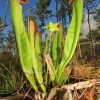- Atlantic St. John’s Wort, Hypericum tenuifolium Synonym: Hypericum reductum
- Beach Morning-glory Ipomoea imperati and Railroad Vine Ipomoea pes-caprae subsp. brasiliensis
- Bitter Panicgrass, Bitter Panicum, Panicum amarum
- Coastal Groundcherry, Physalis angustifolia
- Coastal Sand Frostweed, Crocanthemum arenicola Synonym: Helianthemum arenicola
- Coastalplain Honeycombhead, Balduina angustifolia
- False Rosemary, Conradina canescens
- Florida Rosemary, Ceratiola ericoides
- Goldenaster, Chrysopsis
- Gopher Apple, Geobalanus oblongifolius Synonym: Licania michauxii
- Gulf Bluestem, Maritime Bluestem, Schizachyrium maritimum
- Gulf Coast Lupine, Lupinus westianus var. westianus
- Inkberry, Ilex glabra
- Myrtle Oak, Quercus myrtifolia
- October Flower, Polygonella polygama
- Sand Live Oak, Quercus geminata
- Sandhill Milikweed, Asclepias humistrata
- Sea Oats, Uniola paniculata
- Seabeach Evening Primrose, Oenothera humifusa
- Seacoast Marshelder, Iva imbricata
- Seaside Goldenrod, Solidago sempervirens
- Squareflower, Paronychia erecta
- Wax Myrtle, Morella cerifera Synonym: Myrica cerifera
- Woody Goldenrod, Chrysoma pauciflosculosa
- Yaupon, Ilex vomitoria
Tag: Debbie L. Miller
Native Pitcherplants of Florida (WEC333/UW378)
 Pitcherplants are perennial plants with groups of leaves modified into traps or pitchers. They have tubular leaves with lids or hoods at the top that secrete nectar to attract prey. Once insects are on the lip of the pitcher, they can slip on the waxy opening and fall into the plant. This 5-page fact sheet provides descriptions of the ranges, appearance, and flowering of the six pitcherplant species native to Florida. Written by Megan E. Brown and Debbie L. Miller, and published by the UF Department of Wildlife Ecology and Conservation, January 2013.
Pitcherplants are perennial plants with groups of leaves modified into traps or pitchers. They have tubular leaves with lids or hoods at the top that secrete nectar to attract prey. Once insects are on the lip of the pitcher, they can slip on the waxy opening and fall into the plant. This 5-page fact sheet provides descriptions of the ranges, appearance, and flowering of the six pitcherplant species native to Florida. Written by Megan E. Brown and Debbie L. Miller, and published by the UF Department of Wildlife Ecology and Conservation, January 2013.
http://edis.ifas.ufl.edu/uw378
Florida’s Seepage Slope Wetlands (WEC322/UW367)
 Florida is home to one of North America’s most unique and diverse ecosystems, the seepage slope. Unusual hydrology and frequent fires combine to create an environment that supports a variety of carnivorous and other sun-loving herbaceous plants. This 5-page fact sheet discusses the natural history and conservation concerns associated with seepage slope wetlands. Written by Megan E. Brown and Debbie L. Miller, and published by the UF Department of Wildlife Ecology and Conservation, June 2012.
Florida is home to one of North America’s most unique and diverse ecosystems, the seepage slope. Unusual hydrology and frequent fires combine to create an environment that supports a variety of carnivorous and other sun-loving herbaceous plants. This 5-page fact sheet discusses the natural history and conservation concerns associated with seepage slope wetlands. Written by Megan E. Brown and Debbie L. Miller, and published by the UF Department of Wildlife Ecology and Conservation, June 2012.
http://edis.ifas.ufl.edu/uw367